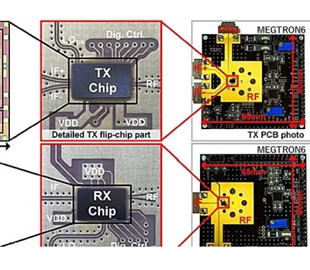
Increasing demand for fast wireless data transmission and processing large amounts of data is forcing researchers to look for new solutions beyond standard millimeter waves. A team of scientists from Japan has developed a chipset based on CMOS technology with the highest data transfer rate among devices with a bandwidth of 56 GHz – 640 Gbps.
The fifth generation of the communication standard (5G) operates at frequencies of 24-47 GHz and supports speeds of up to 10 Gbit/s. The sixth will use even higher frequencies from 110 to 170 GHz, but chipsets for them have yet to be developed. And in such a way as to somehow prevent the attenuation of the signal inherent in this range.

Specialists from the Tokyo Institute of Technology and the National Institute of Information and Communications used a 65-nanometer silicon architecture to create a chipset with a bandwidth of 56 GHz. This chip consists of receiving and transmitting integrated circuits. The dimensions of the transmitting component are only 1.87?3.3 mm, the receiving – 1.65?2.6 mm, reports IE.
In addition, the chipset is equipped with a wide range of amplifiers that improve signal quality. For example, a low-noise amplifier increases signal strength by minimizing interference, while distributed amplifiers improve signal linearity. There is a built-in frequency converter to adjust the frequency. The chip is connected to the external antenna by means of a waveguide, not a transmission line.
In tests, the chipset showed high linearity for multi-level modulation: with a 32 QAM (quadrature modulation) signal and a symbol rate of 40 Gbaud, a speed of 200 Gbit/s. Error rate: less than 10 to the minus third power. When using 16 QAM modulation, the speed at a distance of almost 15 m was 120 Gbps.
To test the chip in a configuration with many inputs and outputs, the scientists connected it to four transmitters and four receivers, each antenna corresponding to for your data stream. In 16 QAM modulation, the speed of each antenna reached 160 Gbit/s, and the total transmission speed – 640 Gbit/s. This is a hundred times faster than current 5G systems.
“The proposed chipset has great potential for next-generation wireless systems, for autonomous cars, telemedicine, advanced virtual reality experiences”, – Professor Kenichi Okada, head of the scientific group, said in a press release.

